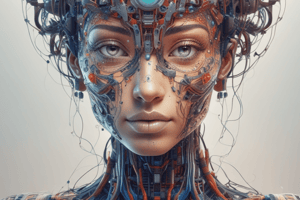Podcast
Questions and Answers
What is the MOST important measure to implement in order to tackle biases in AI systems?
What is the MOST important measure to implement in order to tackle biases in AI systems?
- Ethical guidelines
- Thorough data checks (correct)
- Regular audits
- Ongoing monitoring
Which of the following is a common bias that can affect image recognition systems?
Which of the following is a common bias that can affect image recognition systems?
- Bias towards images of a particular gender
- Bias towards images of a particular geographic region
- Bias towards images of a particular ethnicity (correct)
- Bias towards images of a particular age group
What is the MAIN recommendation for addressing biases in image recognition systems?
What is the MAIN recommendation for addressing biases in image recognition systems?
- Increasing the accuracy of the algorithms
- Using diverse and representative training datasets (correct)
- Implementing more complex neural network architectures
- Relying solely on human reviewers for image classification
Which of the following is a challenge in achieving unbiased AI and machine learning?
Which of the following is a challenge in achieving unbiased AI and machine learning?
What is the role of human reviewers in addressing biases in AI systems?
What is the role of human reviewers in addressing biases in AI systems?
Which of the following is NOT a recommended measure for combating biases in image recognition systems?
Which of the following is NOT a recommended measure for combating biases in image recognition systems?
What type of bias occurs when there is a problem within the algorithm itself?
What type of bias occurs when there is a problem within the algorithm itself?
Which type of bias results from personal beliefs and attitudes of individuals involved in AI system design and deployment?
Which type of bias results from personal beliefs and attitudes of individuals involved in AI system design and deployment?
What issue may arise due to sample bias in AI systems?
What issue may arise due to sample bias in AI systems?
In the context of AI, what does prejudice bias reflect?
In the context of AI, what does prejudice bias reflect?
What can happen as a result of algorithm bias in AI systems?
What can happen as a result of algorithm bias in AI systems?
Which type of bias may arise from inadequate or unrepresentative data used for machine learning model training?
Which type of bias may arise from inadequate or unrepresentative data used for machine learning model training?
Flashcards are hidden until you start studying
Study Notes
KS3 AI and Machine Learning: An Introduction to Bias and Image Recognition
Artificial Intelligence (AI) and Machine Learning (ML) are becoming increasingly integrated into our everyday lives. However, as these technologies grow in popularity, concerns about potential biases and their implications have risen. This article explores the issues surrounding bias in AI, particularly in the context of image recognition, and discusses strategies to minimize these biases.
Bias in AI: Understanding the Challenge
Machine learning bias, also known as algorithm bias or AI bias, arises when an algorithm generates results that are systematically prejudiced due to incorrect assumptions. There are several types of bias that can influence AI systems, including:
- Algorithm bias: Occurs when there is a problem within the algorithm itself, affecting its calculation capabilities.
- Sample bias: Resulting from issues with the data used to train the machine learning model, where the data may not be large enough or representative enough to adequately instruct the system.
- Prejudice bias: Reflecting personal beliefs and attitudes of the individuals involved in designing, training, or deploying the AI systems.
Bias in AI can manifest in various ways, such as biased customer service experiences, reduced sales and revenue, unfair treatment, and even potentially hazardous situations. To tackle these biases, it's essential to implement measures like thorough data checks, regular audits, ethical guidelines, transparency, and ongoing monitoring.
Image Recognition: Combating Biases
Image recognition, a crucial component of many AI applications, can also be influenced by biases. If a system is predominantly trained on images of one particular ethnicity, for example, it might struggle to accurately recognize faces from other ethnic groups. To combat this issue, researchers recommend using diverse and representative training datasets, conducting frequent audits, establishing ethical guidelines, promoting transparency, defining fairness metrics, continuously monitoring the algorithms in operation, and involving human reviewers.
The Future of Unbiased AI and Machine Learning
Despite efforts to address bias in AI, challenges remain, including the trade-off between fairness and accuracy, and keeping up with the dynamic nature of societal norms. Nevertheless, continued innovation and collaboration among researchers and industry experts will hopefully pave the way towards a more equitable and unbiased future for AI and machine learning.
Studying That Suits You
Use AI to generate personalized quizzes and flashcards to suit your learning preferences.




